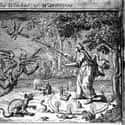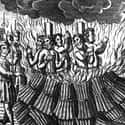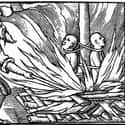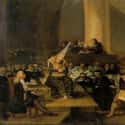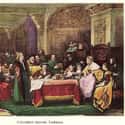-
(#12) The Spectrum Of Potential Crimes Included Witchcraft And Bigamy
Though what counted as "heresy" created a pretty broad umbrella, there was a relatively large spectrum of crimes that might result in an auto de fé. These were largely considered to be crimes against religion. For one, anyone who did not follow the practices of Roman Catholicism might be targeted. But allegations made against someone of things like witchcraft or bigamy could also land that person in front of a tribunal.
-
(#15) One Of The Largest Autos De Fé Happened In Mexico
In some ways, the colonies outdid Europe in terms of autos de fé. The largest auto de fé in the Americas happened in Mexico in 1649. Over 100 so-called "Judaizers" were condemned for supposedly trying to convert people to Judaism. Of those, 13 were burned at the stake.
-
(#2) Some Of It Involved People Being Burned Alive
Perhaps the most extreme sentencing a person could receive during his or her very public auto de fé was burning. Being burned alive was a horribly painful, gruesome way to die - but it also attracted spectators who were hungry for a show. In Logroño, Spain, in 1610, six condemned witches were burned alive, making it the largest witch burning of the Spanish Inquisition. Historians remain divided over exact numbers, but they generally agree that around 3,000 people were burned alive as a result of an auto de fé. Some people were lucky: they were condemned to be burnt in effigy rather than in body.
-
(#9) Prisoners Were Kept In The Dark About Their Fate Until The Auto De Fé
Secrecy was central to the Inquisition proceedings. This meant that prisoners would endure their trials only to have to wait longer to hear their fate. Often, they had to wait several days through the pomp and circumstance of the auto de fé to finally hear their sentence. Officials did this to limit the number of appeals higher courts might receive in the wake of trials. But waiting to hear their fate proved too excruciating for some, and there are records of prisoners committing suicide before hearing their sentencing.
-
(#14) The Accused Had To Wear Special Clothing To Mark And Humiliate Them
As part of the spectacle of the auto de fé, prisoners had to appear in special clothing. Known as the "sanbenito," the garments were a coded yellow tunic that would reveal a prisoner's crimes and fate. They were decorated with symbols and colors. People who were condemned to die wore the Samarra tunic, which had pictures of flames sewn on it. The condemned had to walk through the streets in this garment with a rope around their neck and while carrying a candle. Often, they also wore large pointed hats.
-
(#7) It Was Both Religious And Political
Officially, the auto de fé was part of the Catholic Inquisition. Inquisitions were not civil affairs - they were handled by religious tribunals. At the same time, monarchical and governmental authorities played a part in the process. The Inquisition in Spain ramped up, for example, only when King Ferdinand and Queen Isabella were able to appoint their own Inquisitors and used them to challenge their political enemies.
Civil authorities also collaborated in the Inquisition process, and they would have been present at an auto de fé. Indeed, only civil authorities could condemn an accused person to be burned at the stake - the worst that religious officials could do was sentence someone to life in prison.
New Random Displays Display All By Ranking
About This Tool
Auto De Fe Atomic Portuguese is a public religious trial and confession ceremony in the Middle Ages. The Spanish Inquisition or the Portuguese Inquisition imposed penalties on pagans and heretics. In fact, most of the prisoners were executed by the secular authorities after the confession. The most common victims were former Jews and former Muslims who were apostates.
To understand the nature of the Inquisition, we must understand that the Middle Ages is indeed a backward era. The random tool explained 15 brutal facts about Auto De Fe that you never know, in the centuries that the Inquisition has existed, many improper trials have been conducted in the name of religion.
Our data comes from Ranker, If you want to participate in the ranking of items displayed on this page, please click here.










